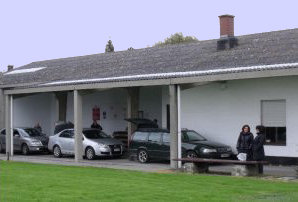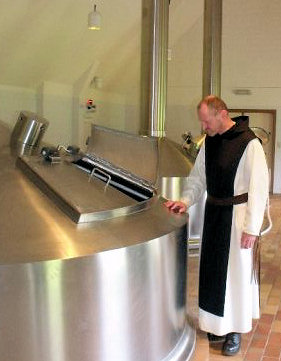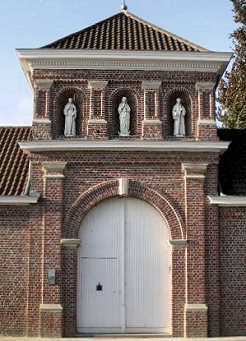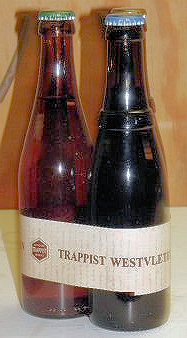 |

|
|

|
|
|
 |

home
about
features
A-Z
books

|

|

features
|

| |
Westvleteren
by Willard Clarke, 11/10
 A line of cars, exhausts smoking in the chill autumn air, is snaking its way round a courtyard that leads to a loading bay at the Abbey of Sint Sixtus at Westvleteren in Belgium. The news has got out: a new batch of beer is ready to be picked up. The lucky few who have ordered in advance have arrived to patiently wait in the queue and then place cases of beer in their vehicles.
Westvleteren, near the hop fields of Poperinge and the town of Ieper/Ypres, is like no other brewery in the world. It's the smallest and most reclusive of the six Trappist breweries in Belgium. The monks don't sell to supermarkets and beer can be bought only from the abbey or from the Cafe In de Vrede (In Peace) across the road.
I'm in the company of Tim Webb, author of the Good Beer Guide to Belgium and a revered figure among drinkers and brewers in this small country with its amazing variety of beer styles. It's his name and good standing that have opened the doors of an abbey usually locked tight against the outside world.
A line of cars, exhausts smoking in the chill autumn air, is snaking its way round a courtyard that leads to a loading bay at the Abbey of Sint Sixtus at Westvleteren in Belgium. The news has got out: a new batch of beer is ready to be picked up. The lucky few who have ordered in advance have arrived to patiently wait in the queue and then place cases of beer in their vehicles.
Westvleteren, near the hop fields of Poperinge and the town of Ieper/Ypres, is like no other brewery in the world. It's the smallest and most reclusive of the six Trappist breweries in Belgium. The monks don't sell to supermarkets and beer can be bought only from the abbey or from the Cafe In de Vrede (In Peace) across the road.
I'm in the company of Tim Webb, author of the Good Beer Guide to Belgium and a revered figure among drinkers and brewers in this small country with its amazing variety of beer styles. It's his name and good standing that have opened the doors of an abbey usually locked tight against the outside world.
 We're greeted by Brother Joris, dressed in the black and white robes of the strict Trappist order. He says that mercifully the queue for beer is relatively small today. He shudders when he recalls
that an American magazine in 2005 had declared the beers of Westvleteren to be the best in the world. As a result, thirsty hordes descended on the abbey, cars waited for hours, engines revving, and
there were even fist fights to get to the front of the queue.
Life has returned to normal five years later but Brother Joris admits there is now a "grey market" for his beers, which can be found in dedicated beer shops or available online. Brother Joris shrugs,
indicating that he cannot control the activities of the outside world and he's happy to be behind the abbey walls. Tim Webb asks him about a rumour that the abbey has done a deal with the supermarket
chain Colruyt to sell the monks' beers. Brother Joris says no deal has been struck but he admits there have been talks. Lapsing into Trappist silence, he won't be drawn further on the subject,
but discussions with other brewers in Belgium suggest that Westvleteren may offer a Christmas gift pack for sale in Colruyt stores.
A large amount of re-building is underway at the abbey and the monks urgently need additional income. But commercial sales can be a mine field. The Koningshoeven abbey in Tilburg in the Netherlands was briefly expelled from the International Trappist Association as a result of having a too-cosy commercial relationship with the big Dutch brewery, Bavaria, and the monks at Sint Sixtus would hate to share the same fate.
We're greeted by Brother Joris, dressed in the black and white robes of the strict Trappist order. He says that mercifully the queue for beer is relatively small today. He shudders when he recalls
that an American magazine in 2005 had declared the beers of Westvleteren to be the best in the world. As a result, thirsty hordes descended on the abbey, cars waited for hours, engines revving, and
there were even fist fights to get to the front of the queue.
Life has returned to normal five years later but Brother Joris admits there is now a "grey market" for his beers, which can be found in dedicated beer shops or available online. Brother Joris shrugs,
indicating that he cannot control the activities of the outside world and he's happy to be behind the abbey walls. Tim Webb asks him about a rumour that the abbey has done a deal with the supermarket
chain Colruyt to sell the monks' beers. Brother Joris says no deal has been struck but he admits there have been talks. Lapsing into Trappist silence, he won't be drawn further on the subject,
but discussions with other brewers in Belgium suggest that Westvleteren may offer a Christmas gift pack for sale in Colruyt stores.
A large amount of re-building is underway at the abbey and the monks urgently need additional income. But commercial sales can be a mine field. The Koningshoeven abbey in Tilburg in the Netherlands was briefly expelled from the International Trappist Association as a result of having a too-cosy commercial relationship with the big Dutch brewery, Bavaria, and the monks at Sint Sixtus would hate to share the same fate.
 The brewery was built in 1838 to supply beer to the monks as well as lay workers constructing buildings at the abbey. In common with all the Trappist monasteries in Belgium, Westvleteren was founded by monks driven out of France at the time of the revolution in the late 18th century. They built small churches that developed over the years into larger abbeys and added breweries that produced beer for the monks to supplement their frugal diets. In the 20th century, the abbeys started to sell beer to the outside world: they needed the income to maintain their churches and fund their religious work in the community.
But to date Westvleteren has shrunk from becoming too commercial. When we mentioned Chimay, best known and most commercial of the Belgian Trappist breweries, Brother Joris shrugged once more. He has very demonstrative shoulders.
He said five monks work in the brewery. Brother Benedikt is head brewer, Brother Joris is in charge of quality control, while Brother Wilhelm runs the laboratory. Their skills are self-taught and are passed on from one generation to the next. They brew occasionally - between 62 and 73 days a year - and produce just 4,500 hectolitres annually.
We follow Brother Joris out of the abbey and down a muddy path to the brewery. The brew house is surprisingly modern, installed in 1989 to replace the original plant. The spacious, white-walled room with the obligatory cross on one wall, is brightly-lit, with a tiled floor and views through large windows of the flat countryside and a nearby hop field. It's a traditional ale brewery, with one stainless steel mash tun supplying two coppers, where the sweet extract of malt sugar is boiled with hops. Three beers are produced: Blond (5.8%), Eight (8%) and Twelve (10.2%). The two stronger beers are russet brown in colour and are the major sellers. In common with other Trappist breweries, Blond was added to keep up with the modern demand for paler beers but its sale is restricted to the Cafe In de Vrede and to those picking up at the abbey. Brother Joris says the beer was intensely bitter and hoppy when it was launched but the hops have been scaled back to make it "more friendly". (In de Vrede is owned by the monks but is leased to a family to run on a commercial basis.)
Blond is an all-malt beer made with a blend of French barleys and Hallertau and Target hops from Poperinge. Water comes from the public supply. The darker beers have brown candy sugar added for colour and Target hops only. Hop pellets are used for Blond but - surprisingly - hop extract is used for the brown beers. This is not unknown among Trappist breweries as Chimay also uses extract.
The brewery was built in 1838 to supply beer to the monks as well as lay workers constructing buildings at the abbey. In common with all the Trappist monasteries in Belgium, Westvleteren was founded by monks driven out of France at the time of the revolution in the late 18th century. They built small churches that developed over the years into larger abbeys and added breweries that produced beer for the monks to supplement their frugal diets. In the 20th century, the abbeys started to sell beer to the outside world: they needed the income to maintain their churches and fund their religious work in the community.
But to date Westvleteren has shrunk from becoming too commercial. When we mentioned Chimay, best known and most commercial of the Belgian Trappist breweries, Brother Joris shrugged once more. He has very demonstrative shoulders.
He said five monks work in the brewery. Brother Benedikt is head brewer, Brother Joris is in charge of quality control, while Brother Wilhelm runs the laboratory. Their skills are self-taught and are passed on from one generation to the next. They brew occasionally - between 62 and 73 days a year - and produce just 4,500 hectolitres annually.
We follow Brother Joris out of the abbey and down a muddy path to the brewery. The brew house is surprisingly modern, installed in 1989 to replace the original plant. The spacious, white-walled room with the obligatory cross on one wall, is brightly-lit, with a tiled floor and views through large windows of the flat countryside and a nearby hop field. It's a traditional ale brewery, with one stainless steel mash tun supplying two coppers, where the sweet extract of malt sugar is boiled with hops. Three beers are produced: Blond (5.8%), Eight (8%) and Twelve (10.2%). The two stronger beers are russet brown in colour and are the major sellers. In common with other Trappist breweries, Blond was added to keep up with the modern demand for paler beers but its sale is restricted to the Cafe In de Vrede and to those picking up at the abbey. Brother Joris says the beer was intensely bitter and hoppy when it was launched but the hops have been scaled back to make it "more friendly". (In de Vrede is owned by the monks but is leased to a family to run on a commercial basis.)
Blond is an all-malt beer made with a blend of French barleys and Hallertau and Target hops from Poperinge. Water comes from the public supply. The darker beers have brown candy sugar added for colour and Target hops only. Hop pellets are used for Blond but - surprisingly - hop extract is used for the brown beers. This is not unknown among Trappist breweries as Chimay also uses extract.
 All three beers are fermented in six open vessels and go to conditioning tanks to mature: four weeks for Blond, six for Eight and seven weeks for Twelve. Primary fermentation lasts for six to
eight days. The unfinished beer then rests for one night before it's transferred to the conditioning tanks. Brother Joris says the beer is not filtered but clears naturally in the vessels.
The beer is pumped to a bottling tank where fresh invert sugar and yeast are added to encourage a second fermentation in bottle. The yeast comes from the Westmalle abbey's brewery and fresh supplies are regularly sourced. Yeast is harvested from the fermenting vessels for bottling. Westvleteren produces only bottle-conditioned beer: there's no draught. Bottles are warm conditioned at 26 degrees Celsius for 10 days.
Brother Joris takes us back to the abbey for a tasting of the beers. The bottles have no labels and are distinguished by different coloured caps: green for Blond, blue for Eight, gold for Twelve.
I sample the beers and give out a long sigh. Brother Joris looks alarmed. "Is that good or bad?" he asks. Tim Webb assures him it mean "good": Brother Joris may have demonstrative shoulders but I let my tastebuds do the talking.
Allowed to jump the queue, Tim and I buy a crate each of Westvleteren's beers. As we drive out a young Italian flags us down and begs us to sell him one of our crates. He hasn't ordered in advance and can't get any beer. Lacking Christian charity, we decline and drive off with our cherished bottles. No doubt behind the abbey walls Brother Joris is sadly shrugging his shoulders.
All three beers are fermented in six open vessels and go to conditioning tanks to mature: four weeks for Blond, six for Eight and seven weeks for Twelve. Primary fermentation lasts for six to
eight days. The unfinished beer then rests for one night before it's transferred to the conditioning tanks. Brother Joris says the beer is not filtered but clears naturally in the vessels.
The beer is pumped to a bottling tank where fresh invert sugar and yeast are added to encourage a second fermentation in bottle. The yeast comes from the Westmalle abbey's brewery and fresh supplies are regularly sourced. Yeast is harvested from the fermenting vessels for bottling. Westvleteren produces only bottle-conditioned beer: there's no draught. Bottles are warm conditioned at 26 degrees Celsius for 10 days.
Brother Joris takes us back to the abbey for a tasting of the beers. The bottles have no labels and are distinguished by different coloured caps: green for Blond, blue for Eight, gold for Twelve.
I sample the beers and give out a long sigh. Brother Joris looks alarmed. "Is that good or bad?" he asks. Tim Webb assures him it mean "good": Brother Joris may have demonstrative shoulders but I let my tastebuds do the talking.
Allowed to jump the queue, Tim and I buy a crate each of Westvleteren's beers. As we drive out a young Italian flags us down and begs us to sell him one of our crates. He hasn't ordered in advance and can't get any beer. Lacking Christian charity, we decline and drive off with our cherished bottles. No doubt behind the abbey walls Brother Joris is sadly shrugging his shoulders.
The tasting
Westvleteren Blond
Big spicy, peppery hop aroma with lemon fruit and cracker-like malt. Tart citrus fruit and bitter, peppery hops dominate the mouth but are balanced by juicy malt. The finish is dry with tangy hop resins, tart fruit and rich malt.
Westvleteren Eight
Herbal, spicy aroma with rich biscuity malt and a hint of apple fruit. Chocolate comes through in the mouth with growing hop resins and bittersweet fruit. The finish is dry with tangy hops, dark malt and chocolate.
Westvleteren Twelve
big fluffy head with a massive nose of "fruit and veg" - celery, raisins, sultanas, burnt grain, cobnuts and dry chocolate. Sweet grain coats the tongue with chocolate, followed by herbal notes with spicy hop resins kicking in. A rich, sweet finish has vinous fruit, chocolate, toffee and light hops.
The facts
Abdij Sint Sixtus
Donkerstraat 12
8640 Westvleteren
Belgium
0032 (0)70 21.00.45
See www.sintsixtus.be for information on how to order beer.
Cafe In de Vrede
Donkerstraat 13
8640 Westvleteren
0032 (0) 57 40.03.77
See www.indevrede.be for opening times. Beers on sale along with soups and snacks.
|
|
home
about
features
A-Z
books
|

